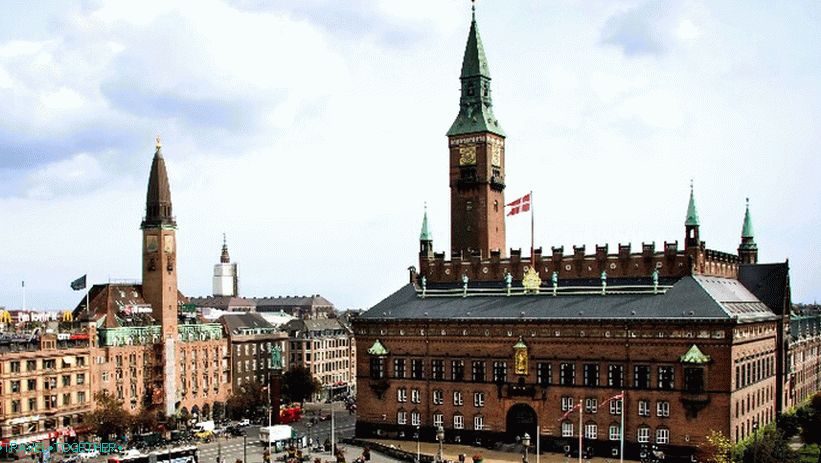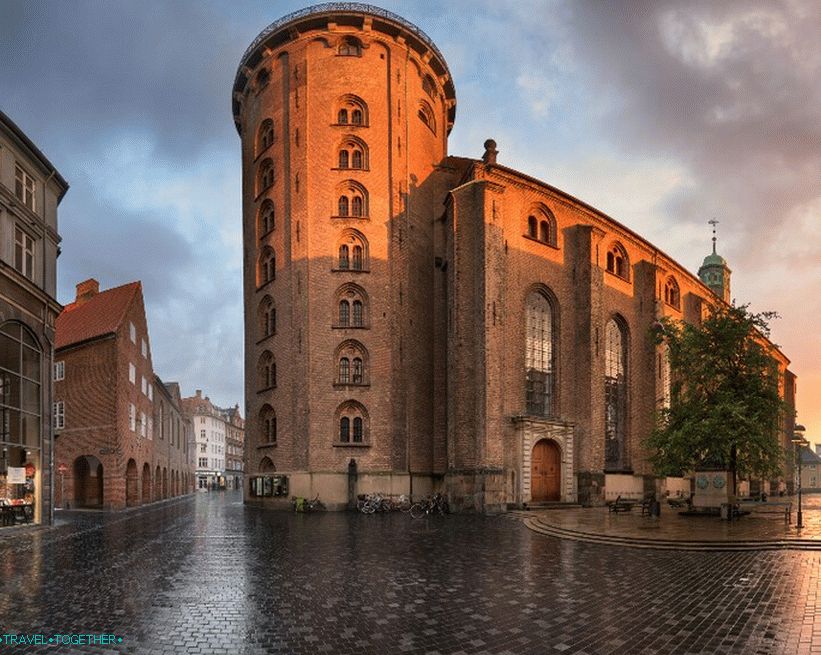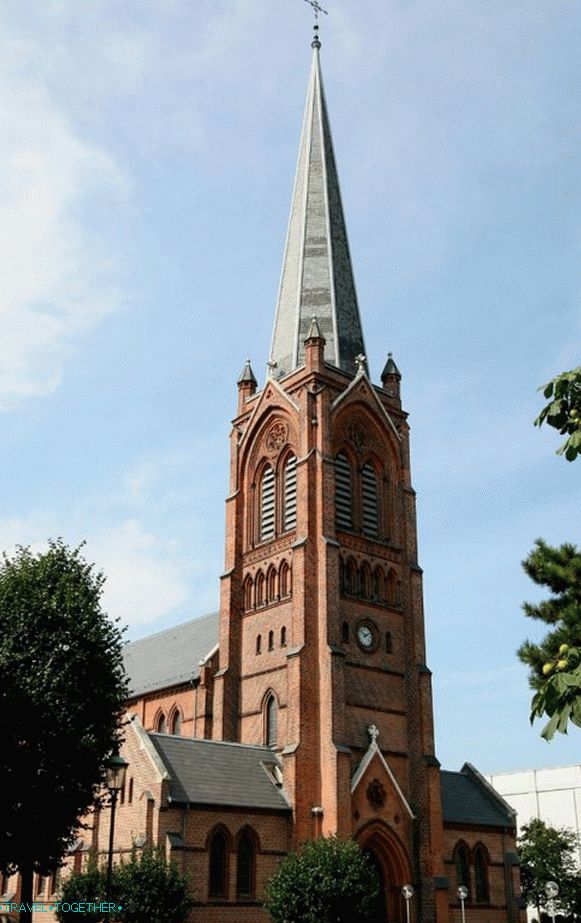Copenhagen (Denmark) – the most detailed information about the city with photos. Description of the main attractions of Copenhagen, guidebooks and cards.
Contents
Copenhagen City (Denmark)
Copenhagen is the capital of Denmark and its largest city. Located in the western part of the country on the islands of Zeeland, Slotsholmen and Amager with view of the Öresund strait. Copenhagen – one of the most beautiful European cities that geographically and culturally connects Scandinavia and Europe. This is probably the quietest of Scandinavian capitals, which will amaze you with charming provincial charm, wonderful sea atmosphere and sights of the world level Copenhagen is a place where old tales coexist with modernity, and warm jazz is mixed with cold electronics.
Once upon a time (in the 11th century) at the site of the future capital of Denmark there was a small fishing village. Further thanks to Maritime trade and fishing here grew rich city and big port. Especially the port atmosphere is felt in the New harbor filled with bright merchant houses, boats and ships. Now Copenhagen is one of the main financial and cultural centers. Northern Europe. The city is famous for its friendly locals, interesting street and night life, unique food culture, beautiful historic architecture, many palaces, old churches and museums.
- Geography and climate
- Practical information
- Story
- How to get there
- sights
- Video
- Maps and guides
- Comments and reviews
Geography and climate
Copenhagen is located in the west of Denmark on the islands of Zealand, Slotsholmen and Amager. The Öresund strait separates the capital of Denmark from Sweden The climate of Copenhagen is temperate maritime. Summer is relatively cool and rainy. Winter is quite mild with small negative temperatures and unstable snow cover.
 Copenhagen
Copenhagen
Practical information
- The population is 616 thousand people.
- The area is 86.40 km2.
- The language is Danish.
- Currency – Danish Krone.
- Time – UTC +1, summer +2.
- Visa – Schengen.
- VAT in Denmark is 25%. Tax can be returned from the purchase of 300 DKK.
- One of the most popular shopping streets of Copenhagen is Strøget with a variety of trendy and designer stores. Lot interesting shops are also located on the narrow streets in her surroundings.
- Flea markets are called Loppemarked in Danish. Similar market open on Saturdays near the central station, as well as on square behind the town hall, on the museum square and in Nørrebro.
- Today, Copenhagen is a popular destination for gastronomic tourism. Gourmets from all over the world come to the capital of Denmark to get acquainted with modern culinary trends. But this does not mean that you can not find cheap food In Pølsevogn (literally “sausage truck”) you can buy relatively cheap hot dogs and sausages. Also on the streets Copenhagen enough Denier and similar fast food. For, not expensive to drink coffee and try local pastries peek into local bakeries.
- The most popular drink in Denmark is beer (mostly this is Carlsberg or Tuborg). Beer in bars and restaurants costs 20-40 Danish crowns. But it is legal and very popular to drink beer in public places (except public transport). Therefore, you can take a beer in near the supermarket and enjoy a drink right on the street.
 Areas Copenhagen
Areas Copenhagen
Copenhagen districts
- Indre By is a medieval center and Copenhagen’s historic heart with beautiful narrow streets historical houses, landmarks, historical monuments and culture.
- Christianshavn – working district with numerous channels, built three hundred years ago. Today is a trendy place with vibrant nightlife.
- Vesterbro is one of the most fashionable places to live with many cafes, restaurants and hotels.
- Frederiksberg is a small town that grew up around of the castle of the same name. Now he is practically surrounded by Copenhagen, but still a separate municipality.
- Nørrebro – one of the busiest parts Copenhagen with a lot of immigrants and students.
- Østerbro (Østerbro) – a cozy area north of the center, in the harbor which is the famous little mermaid.
- Amager (Amager) – an island with its own special atmosphere and international airport.
- Vestegnen – south-western suburbs with beaches and campsites
Story
In the 11th and 12th centuries a small area was located on the site of Copenhagen. fishing village. Everything changed in 1160, when the king Waldemar transferred control of the settlement to Archbishop Roskilde Absalon This influential churchman built a castle here (on Slotsholmen Island) and laid the foundations for the prosperity of the future cities.
 Panorama Copenhagen
Panorama Copenhagen
In 1254, Copenhagen received city privileges. In 1416 the city was conquered by king eric pomeransky who made it his residence. Due to its strategic position (on the bank of the important Öresund strait) and the fishery Copenhagen grew and grew rich. But not all the wealth and status of the new the city came to taste. During the Middle Ages, Copenhagen was several times looted and ravaged. Hanseatic League once in general completely destroyed the city.
 Streets Copenhagen
Streets Copenhagen
After the Reformation, the Danish king finally moved the capital kingdom in copenhagen. New fortifications were built and many buildings. In the middle of the 17th century, Copenhagen weathered the Swedish siege. In 1728, a strong fire destroyed 25% of the city. Early 19 century Copenhagen was significantly damaged by an English squadron under the command of Admiral Nelson. Despite this, the 19th century is considered a golden age for Copenhagen.
 Streets Copenhagen
Streets Copenhagen
In the 19th century, most of the old fortifications were dismantled. K 20 century Copenhagen has become a thriving industrial city. The capital of Denmark practically did not suffer during the two world wars. Today, Copenhagen is considered one of the most comfortable cities. for life.
 Copenhagen
Copenhagen
How to get there
Copenhagen International Airport is called Kastrup and located on the island of Amager. Many passengers consider it much more comfortable and functional than, for example, London Heathrow or Frankfurt Airport. The airport serves the following directions: Milan, Hamburg, Berlin, Paris, London, Stockholm, Helsinki, Amsterdam, Budapest, Geneva, Vienna, Warsaw and several intercontinental flights. From the airport to the city center is convenient get on the subway. Trains run every 4 minutes and the journey will take 12-14 minutes.
 Copenhagen
Copenhagen
Copenhagen public transport has a zonal system. Tickets can be bought in special machines at subway stations, in DBS ticket office at the airport or at the driver on the bus.
Copenhagen has excellent rail and bus services. communication with most cities in Denmark, as well as Malmo, Gothenburg, Lund, Hamburg, Berlin, Gdansk. Also the capital of Denmark has regular ferry service from Oslo.
sights
 Mermaid
Mermaid
The Little Mermaid is one of the symbols of Copenhagen. This bronze statue located on the quay Langelinie and is dedicated to the heroine of the famous all fairy tales H. K. Andersen. The sculpture, created by E. Eriksen, was opened on August 23, 1913 and became a gift of the Danish brewer Carl Jacobsen city of Copenhagen.
The sculpture is made of bronze and granite and is inspired by a fairy tale. Andersen about the mermaid who throws everything for the love of the young the prince. Every morning and evening she comes to the surface from the sea the abysses and, sitting on a rock, longingly looks at the shore hoping see your loved one.
 Citadel
Citadel
Not far from the pier Langelinie is located Castellet. (Kastellet) – the former citadel of Frederikshavn, the oldest parts which date back to the year 1625.
 New Harbor
New Harbor
New Harbor (Nyhavn) – the most charming place of Copenhagen with beautiful bright old houses, great restaurants, relaxed atmosphere and boats moored along the canal. Originally (in the 17th century) Nyhavn was a lively trading port, in which could come ships from around the world. The pier was filled with sailors, pubs and pubs.
 Town hall
Town hall
Copenhagen Town Hall is located on a busy square and was built between 1892 and 1905. The building represents a combination of Italian renaissance and medieval Danish architecture. The 106 meter high tower is the highest in the city. Above the main entrance you can see the figure of Bishop Absalon, who actually founded Copenhagen. Town Hall is richly decorated sculptures and paintings.
 Round Tower (Rundetårn)
Round Tower (Rundetårn)
Round tower (Rundetårn) – one of the most famous structures Copenhagen. The building was built in the 17th century as an observatory. The tower has a height of 36 meters and is still in use. amateur astronomers.
 Tivoli
Tivoli
Tivoli is one of the most famous amusement parks in Europe, including more than 20 rides: roller coasters, carousels, mirrored halls, theaters and much more. Tivoli Park was founded in 1843 and became a real national treasure. His few once visited the storyteller Andersen, and Walt Disney himself found here inspiration for your own world. Tivoli is beautiful landscape with exotic architecture, historic buildings and lush gardens. At night, thousands of colored lights create here. totally unique fabulous atmosphere.
The oldest amusement park in the world – Bakken, located about 20 minutes north of Copenhagen, represents is a simple version of tivoli.
 Strøget (Strøget)
Strøget (Strøget)
Strøget is the largest shopping district of Copenhagen, which is centered around the eponymous street. Strøget – one of Europe’s longest pedestrian streets with many shops – from low-cost networks to the most fashionable brands.
Castles and palaces
 Kronborg
Kronborg
Kronborg is probably the most famous Danish castle thanks “Hamlet” by W. Shakespeare. It is included in the UNESCO list and is located on Cape in North Zealand between Elsinore and Swedish Helsingborg. Grand fortifications with bastions and casemates used to protect the Danish land from enemies and were the residence of the royal family until the end of the 17th century. Kronborg has beautifully decorated rooms with Renaissance and interiors baroque.
 Christiansborg
Christiansborg
Christiansborg – a palace with eight centuries of history, located on the tiny island of Slotsholmen. It is here that the archbishop Absalon built his castle, around which the future grew Copenhagen. The ruins of an ancient castle and fortress were discovered in the construction of the palace. Christiansborg was built in 1760 in baroque style. Now it houses the Danish Parliament and Supreme Court.
 Amalienborg
Amalienborg
Amalienborg – an impressive rococo palace complex, built between 1746 and 1766 during the reign of Frederick V. The Palace is the official residence of the Danish Royal family and consists of four buildings that face the large square. One of the main symbols of Amalienborg is Royal guard.
 Rosenborg
Rosenborg
Rosenborg was built by one of the most famous Scandinavian Kings Christian IV at the beginning of the 17th century and for some time was residence of the royal family. Among his main attractions: the knight’s hall with royal thrones and three life-sized silver lions standing on guard, tapestries on the walls and well-preserved interiors. Now here is the royal hermitage, which stores precious art objects and royal regalia.
 Frederiksborg
Frederiksborg
Frederiksborg – an impressive 17th century renaissance castle, built by Christian IV and located in Hillerode north of Copenhagen. Now in its walls is a museum of national stories in which beautifully decorated rooms with portraits, historical paintings, furniture and decorative art will hold visitors on a journey through Danish history and culture from the late Medieval to our days. Historic interiors and luxurious rooms create the feeling of changing styles and eras, and a collection of portraits is the largest and most significant in Denmark.
Churches of Copenhagen
 Church of the Savior
Church of the Savior
The Church of the Savior – a beautiful Baroque brick church of the end 17 century near Christianshavn, best known for its screw the spire and the largest carillon in northern Europe. Building built in the style of the Dutch Baroque in the form of a Greek cross. Walls based on a granite foundation and made of red and yellow brick.

Marble Church (Frederick’s Church) – Lutheran Church in Rococo style, located to the west of Amalienborg Palace. Building It was designed by architect Nikolai Eygtved in 1740 and completed only at the end of the 19th century.
 Church Grundtvig
Church Grundtvig
Grundtvig Church – a Lutheran church built in the first half of the 20th century. It is one of the most famous buildings. Copenhagen and a unique example of expressionism. Church of yellow brick has the features of traditional Danish churches, Gothic, Baroque and various currents of modernism.
 Church of sv. Paul’s
Church of sv. Paul’s
Church of sv. Pavla – brick Lutheran church of the late 19th century in the architectural style of the Gothic Renaissance.
 Church of sv. Nikolay
Church of sv. Nikolay
Church of sv. Nicholas – a former religious building in style Neo-Baroque with a powerful tower with a high spire. The first building was built at the beginning of the 13th century and is the third oldest church Copenhagen. After a fire in 1795, the church was closed and from 1805 year is not a religious structure. Now located here center of contemporary art.
 Church of sv. Of the spirit
Church of sv. Of the spirit
Church of sv. The Spirit is one of the oldest churches in Copenhagen, founded in 1238 by the Franciscan monks. Originally it was the first and only monastery of the city, transformed in 1296 year to the hospital, and in 1469 – to the abbey. After the Reformation the monastery was closed, and the church became Lutheran.
 Church of sv. Jacob
Church of sv. Jacob
Church of sv. Jacob – a beautiful brick neo-gothic church late 19th century.
Copenhagen Museums
- The National Museum is located in the former royal palace 18 century. Here are the exhibitions of the Stone Age, the Viking Age, Middle Ages, Renaissance and Modern Danish stories.
- National Gallery (SMK) – Denmark’s largest art a museum that presents outstanding collections of Danish and international art over the past seven centuries.
- Glyptotek – Art Museum, founded in 1888 brewer Carl Jacobsen. The department of antiquities keeps beautiful collections of Egyptian, Greek, Etruscan and Roman art. The modern department presents Danish painting and sculpture 19 and 20 centuries, as well as French art of the same period.
- The open-air museum (Frilandsmuseet) is one of The oldest and largest museums of this kind in the world. Counts more 50 farms, mills and houses from the period of 1650-1940.
- Museum of Contemporary Art (Arken) – one of the best in Scandinavian collections of contemporary art from the greatest modernist artists to young talents
Video
Maps and guides
City map






